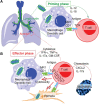Targeting Innate-Like T Cells in Tuberculosis
- PMID: 28066410
- PMCID: PMC5175204
- DOI: 10.3389/fimmu.2016.00594
Targeting Innate-Like T Cells in Tuberculosis
Abstract
Peptide-specific conventional T cells have been major targets for designing most antimycobacterial vaccines. Immune responses mediated by conventional T cells exhibit a delayed onset upon primary infection and are highly variable in different human populations. In contrast, innate-like T cells quickly respond to pathogens and display effector functions without undergoing extensive clonal expansion. Specifically, the activation of innate-like T cells depends on the promiscuous interaction of highly conserved antigen-presenting molecules, non-peptidic antigens, and likely semi-invariant T cell receptors. In antimicrobial immune responses, mucosal-associated invariant T cells are activated by riboflavin precursor metabolites presented by major histocompatibility complex-related protein I, while lipid-specific T cells including natural killer T cells are activated by lipid metabolites presented by CD1 proteins. Multiple innate-like T cell subsets have been shown to be protective or responsive in mycobacterial infections. Through rapid cytokine secretion, innate-like T cells function in early defense and memory response, offering novel advantages over conventional T cells in the design of anti-tuberculosis strategies.
Keywords: CD1; MR1; Mycobacterium tuberculosis; antigen presentation; innate-like T cells; lipid; riboflavin metabolites; vaccine.
Figures





Similar articles
-
Mucosal-Associated Invariant T Cells Develop an Innate-Like Transcriptomic Program in Anti-mycobacterial Responses.Front Immunol. 2020 Jun 9;11:1136. doi: 10.3389/fimmu.2020.01136. eCollection 2020. Front Immunol. 2020. PMID: 32582206 Free PMC article.
-
Functional Heterogeneity and Antimycobacterial Effects of Mouse Mucosal-Associated Invariant T Cells Specific for Riboflavin Metabolites.J Immunol. 2015 Jul 15;195(2):587-601. doi: 10.4049/jimmunol.1402545. Epub 2015 Jun 10. J Immunol. 2015. PMID: 26063000 Free PMC article.
-
Human MAIT-cell responses to Escherichia coli: activation, cytokine production, proliferation, and cytotoxicity.J Leukoc Biol. 2016 Jul;100(1):233-40. doi: 10.1189/jlb.4TA0815-391RR. Epub 2016 Mar 31. J Leukoc Biol. 2016. PMID: 27034405 Free PMC article.
-
The role of donor-unrestricted T-cells, innate lymphoid cells, and NK cells in anti-mycobacterial immunity.Immunol Rev. 2021 May;301(1):30-47. doi: 10.1111/imr.12948. Epub 2021 Feb 2. Immunol Rev. 2021. PMID: 33529407 Free PMC article. Review.
-
CD1 proteins: targets of T cell recognition in innate and adaptive immunity.Rev Immunogenet. 2000;2(3):416-32. Rev Immunogenet. 2000. PMID: 11256748 Review.
Cited by
-
Comparative transcriptomes reveal pro-survival and cytotoxic programs of mucosal-associated invariant T cells upon Bacillus Calmette-Guérin stimulation.Front Cell Infect Microbiol. 2023 Apr 6;13:1134119. doi: 10.3389/fcimb.2023.1134119. eCollection 2023. Front Cell Infect Microbiol. 2023. PMID: 37091679 Free PMC article.
-
Association between genetic variants in CD1A and CD1D genes and pulmonary tuberculosis in an Iranian population.Biomed Rep. 2019 Apr;10(4):259-265. doi: 10.3892/br.2019.1201. Epub 2019 Mar 15. Biomed Rep. 2019. PMID: 30972222 Free PMC article.
-
Decreased Frequencies of Gamma/Delta T Cells Expressing Th1/Th17 Cytokine, Cytotoxic, and Immune Markers in Latent Tuberculosis-Diabetes/Pre-Diabetes Comorbidity.Front Cell Infect Microbiol. 2021 Oct 26;11:756854. doi: 10.3389/fcimb.2021.756854. eCollection 2021. Front Cell Infect Microbiol. 2021. PMID: 34765568 Free PMC article.
-
Natural Killer T Cell Diversity and Immunotherapy.Cancers (Basel). 2023 Dec 7;15(24):5737. doi: 10.3390/cancers15245737. Cancers (Basel). 2023. PMID: 38136283 Free PMC article. Review.
-
MAIT cells in bacterial infectious diseases: heroes, villains, or both?Clin Exp Immunol. 2023 Dec 12;214(2):144-153. doi: 10.1093/cei/uxad102. Clin Exp Immunol. 2023. PMID: 37624404 Free PMC article. Review.
References
-
- Orme IM, Collins FM. Adoptive protection of the Mycobacterium tuberculosis-infected lung. Dissociation between cells that passively transfer protective immunity and those that transfer delayed-type hypersensitivity to tuberculin. Cell Immunol (1984) 84(1):113–20.10.1016/0008-8749(84)90082-0 - DOI - PubMed
Publication types
Grants and funding
LinkOut - more resources
Full Text Sources
Other Literature Sources

